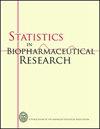Pocock和Simon协变量自适应随机化研究中时间到事件终点检验的有效性
IF 1.5
4区 医学
Q3 MATHEMATICAL & COMPUTATIONAL BIOLOGY
引用次数: 1
摘要
临床试验中经常采用随机化程序,以加强预后因素的平衡,最常见的是分层随机化。当因子数量或因子水平较大时,动态分配程序,如Pocock和Simon的协变量自适应随机化(最小化)是首选。在他们开创性的工作中,Ye和Shao(2020)确定了两类协变量自适应随机化程序。他们从理论上证明,对于这些类别,当模型被错误指定时,稳健分数检验(Lin和Wei, 1989)以及用于分析事件时间端点的非分层对数秩检验是有效的或保守的(Ye和Shao, 2020)。然而,这一事实并不是为了最小化而建立的,而是通过生存终点的模拟。在本文中,我们指出Ye和Shao的结果可以扩展到更一般的随机化过程。我们通过部分理论和部分地层内不平衡的模拟表明,最小化属于这一类。在此过程中,我们描述了在所有地层中具有相同流行率的最小化后归一化地层内不平衡的渐近相关矩阵。我们将Ye和Shao提出的分层随机化鲁棒性检验扩展到最小化,并通过模拟检验其性能。关键词:最小化I型错误稳健生存分析测试免责声明作为对作者和研究人员的服务,我们提供此版本的已接受稿件(AM)。在最终出版版本记录(VoR)之前,将对该手稿进行编辑、排版和审查。在制作和印前,可能会发现可能影响内容的错误,所有适用于期刊的法律免责声明也与这些版本有关。本研究没有从公共、商业或非营利部门的资助机构获得任何特定的资助。作者要感谢匿名审稿人,他们的建议大大改进了本文。作者报告说,没有与本文所述工作相关的资金。本文章由计算机程序翻译,如有差异,请以英文原文为准。
Validity of tests for time-to-event endpoints in studies with the Pocock and Simon covariate-adaptive randomization
AbstractRandomization procedures that enforce balance in prognostic factors, most commonly stratified randomization, are often employed in clinical trials. When the number of factors or factor levels is large, dynamic allocation procedures, such as the Pocock and Simon’s covariate-adaptive randomization (minimization) are preferred. In their ground-breaking work Ye and Shao (2020) identified two classes of covariate-adaptive randomization procedures. They have demonstrated theoretically that for these classes, when the model is misspecified, the robust score test (Lin and Wei, 1989) as well as the unstratified log-rank test used for analysis of time-to-event endpoints, are valid or conservative (Ye and Shao, 2020). This fact, however, was not established for minimization other than through simulations of survival endpoints. In this paper, we point out that the results of Ye and Shao can be expanded to a more general class of randomization procedures. We show, in part theoretically, in part through simulations of the within-strata imbalances, that minimization belongs to this class. Along the way we describe the asymptotic correlation matrix of the normalized within-stratum imbalances following minimization with equal prevalence of all strata. We expand the robust tests proposed by Ye and Shao for stratified randomization to minimization and examine their performance through simulations.Keywords: minimizationType I errorrobust survival analysis testsDisclaimerAs a service to authors and researchers we are providing this version of an accepted manuscript (AM). Copyediting, typesetting, and review of the resulting proofs will be undertaken on this manuscript before final publication of the Version of Record (VoR). During production and pre-press, errors may be discovered which could affect the content, and all legal disclaimers that apply to the journal relate to these versions also. AcknowledgementsThis research did not receive any specific grant from funding agencies in the public, commercial, or not-for-profit sectors. The authors would like to thank the anonymous reviewers whose recommendations substantially improved the paper.FundingThe author(s) reported there is no funding associated with the work featured in this article.
求助全文
通过发布文献求助,成功后即可免费获取论文全文。
去求助
来源期刊

Statistics in Biopharmaceutical Research
MATHEMATICAL & COMPUTATIONAL BIOLOGY-STATISTICS & PROBABILITY
CiteScore
3.90
自引率
16.70%
发文量
56
期刊介绍:
Statistics in Biopharmaceutical Research ( SBR), publishes articles that focus on the needs of researchers and applied statisticians in biopharmaceutical industries; academic biostatisticians from schools of medicine, veterinary medicine, public health, and pharmacy; statisticians and quantitative analysts working in regulatory agencies (e.g., U.S. Food and Drug Administration and its counterpart in other countries); statisticians with an interest in adopting methodology presented in this journal to their own fields; and nonstatisticians with an interest in applying statistical methods to biopharmaceutical problems.
Statistics in Biopharmaceutical Research accepts papers that discuss appropriate statistical methodology and information regarding the use of statistics in all phases of research, development, and practice in the pharmaceutical, biopharmaceutical, device, and diagnostics industries. Articles should focus on the development of novel statistical methods, novel applications of current methods, or the innovative application of statistical principles that can be used by statistical practitioners in these disciplines. Areas of application may include statistical methods for drug discovery, including papers that address issues of multiplicity, sequential trials, adaptive designs, etc.; preclinical and clinical studies; genomics and proteomics; bioassay; biomarkers and surrogate markers; models and analyses of drug history, including pharmacoeconomics, product life cycle, detection of adverse events in clinical studies, and postmarketing risk assessment; regulatory guidelines, including issues of standardization of terminology (e.g., CDISC), tolerance and specification limits related to pharmaceutical practice, and novel methods of drug approval; and detection of adverse events in clinical and toxicological studies. Tutorial articles also are welcome. Articles should include demonstrable evidence of the usefulness of this methodology (presumably by means of an application).
The Editorial Board of SBR intends to ensure that the journal continually provides important, useful, and timely information. To accomplish this, the board strives to attract outstanding articles by seeing that each submission receives a careful, thorough, and prompt review.
Authors can choose to publish gold open access in this journal.
 求助内容:
求助内容: 应助结果提醒方式:
应助结果提醒方式:


